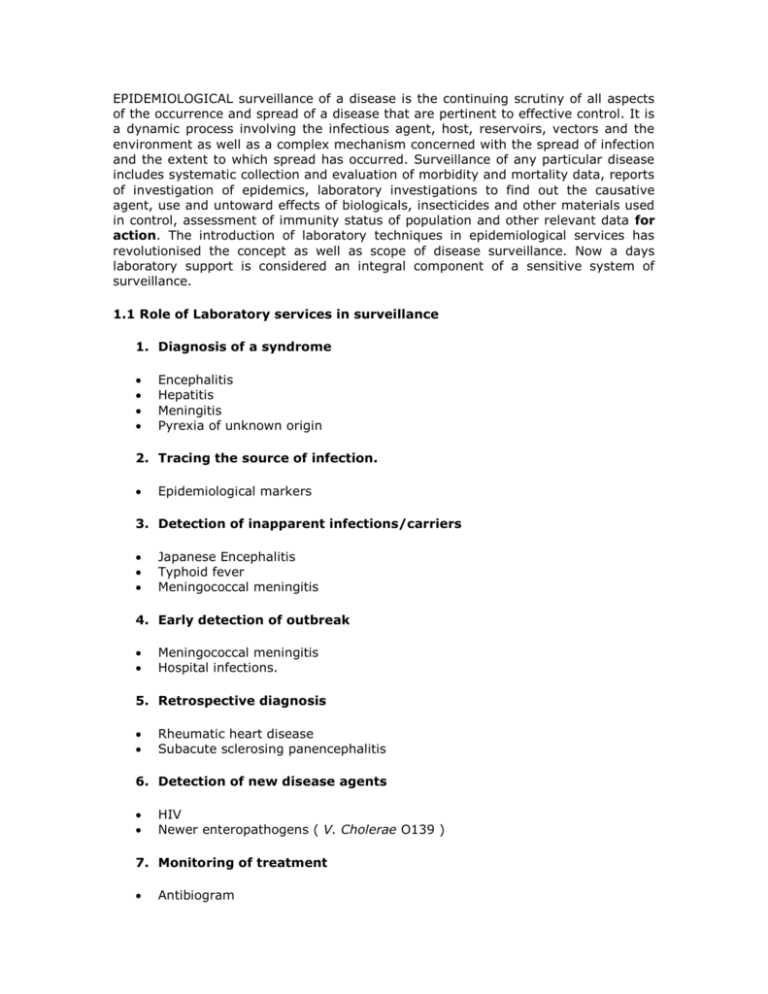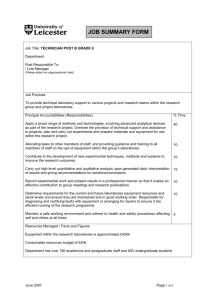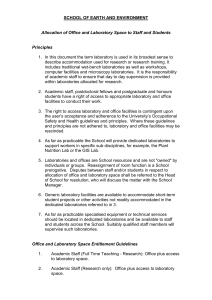EPIDEMIOLOGICAL surveillance of a disease is the continuing
advertisement

EPIDEMIOLOGICAL surveillance of a disease is the continuing scrutiny of all aspects of the occurrence and spread of a disease that are pertinent to effective control. It is a dynamic process involving the infectious agent, host, reservoirs, vectors and the environment as well as a complex mechanism concerned with the spread of infection and the extent to which spread has occurred. Surveillance of any particular disease includes systematic collection and evaluation of morbidity and mortality data, reports of investigation of epidemics, laboratory investigations to find out the causative agent, use and untoward effects of biologicals, insecticides and other materials used in control, assessment of immunity status of population and other relevant data for action. The introduction of laboratory techniques in epidemiological services has revolutionised the concept as well as scope of disease surveillance. Now a days laboratory support is considered an integral component of a sensitive system of surveillance. 1.1 Role of Laboratory services in surveillance 1. Diagnosis of a syndrome Encephalitis Hepatitis Meningitis Pyrexia of unknown origin 2. Tracing the source of infection. Epidemiological markers 3. Detection of inapparent infections/carriers Japanese Encephalitis Typhoid fever Meningococcal meningitis 4. Early detection of outbreak Meningococcal meningitis Hospital infections. 5. Retrospective diagnosis Rheumatic heart disease Subacute sclerosing panencephalitis 6. Detection of new disease agents HIV Newer enteropathogens ( V. Cholerae O139 ) 7. Monitoring of treatment Antibiogram Antibiotic levels in sewm 8. Quality control of biologicals Vaccine potency testing Vaccine safety studies 9. Prevalence studies Sero-surveys Immune status 10.Find out natural foci of infection Plague Leptospirosis 11.Controlled field trials. Newer drugs/vaccines Newer regimens of drugs/vaccines Key to successful laboratory based surveillance lies in Right Right Right Right sample collection. time to collect samples for disease surveillance. methodology for transportation of sample. laboratory to be chosen Identify right patient | Order relevent tests | Collect appropriate specimens of good quality | Label appropriately & fill proforma | Transport properly to laboratory | Record properly in laboratory | Perform accurate and precise analysis | Document and report | Interpret | Take timely action on right patient Fig 1.1:Algorithm for ensuring good laboratory results 1.2 Networking of laboratories Central or National Reference Laboratory | | | Regional Laboratory | Regional Laboratory Regional Lab | | | District Labs | District Labs District Labs | | | Peripheral Lab | Peripheral Lab Peripheral Lab Fig 1.2: Networking of laboratories 1.3 Peripheral laboratory These laboratories are located at the point of first major contact of patients with the health care services. In most of the developing countries these are available only at primary health centre or community health centre (upgraded primary health centres). These laboratories provide technical support for preventive, curative and promotive services for the individual as well as the community. These laboratories are supposed to carry out limited basic investigations eg. micros copy for malaria and Tuberculosis other than these, these laboratories should concentrate on people collection, storage and temporisations of clinical samples to district laboratory. 1.3.1 Staff The staff in peripheral laboratories should include one technician and one laboratory assistant/attendant. 1.3.2 Space Space available in peripheral laboratories should include at least one laboratory-cum-office/record room (16 ft x10 ft ) and one store-room combined with other services (16 ft x10 ft). 1.3.3 Other facilities Other necessary facilities include - a supply of safe water, - a reliable source of energy (battery, electricity, solar or kerosene) and - sterilization facilities and waste disposal There must also be transport and communication facilities between the peripheral and intermediate laboratories for referral of samples and patients, procurement of supplies and personal discussion. 1.3.4 Tests to be performed (District Laboratory) Table 1.1: Suggested microbiological tests at district laboratories Procedure/Specimen Disease/Organism Microscopy for stained smearsDiphtheria, Vincent's angina (Gram, Albert,Ziehl Neelsen) Sputum (Mocros copy) Tuberculosis, pneumonia CSF Meningitis (Micros copy and latex Agglutination test) (pyogenic & tuberculosis) Stool Cholera/dysentery Culture Cholera Enteric fever (Widal) Serological tests RPR/VDRL Dipstick and Particle agglutination test HBsAg, HIV Water Bacteriological analysis These laboratories are expected to undertake tests of public health as well as clinical relevance. Amongst the tests of public health relevance, diseases of greater epidemiological importance should be accorded priority. Testing of environmental samples (especially water) also falls into the priorities of public health relevance. Certain serological tests may be of use in studying epidemiological pattern of the important diseases and the same can be performed at peripheral laboratories (Table 1.1) As far as possible, these tests should be reliable, sensitive, specific, rapid, easy to perform and cost effective. Equipment and supplies. Necessary equipment and supplies include: good microscopes, centrifuge, transport media, glassware, sterile swabs, reagents for staining (eg. Gram, Albert, Ziehl Neelsen, Romanowsky), kits and reagents for rapid diagnostic tests, sterilized syringes and needles, micropipettes and tips as well as sterile collection bottles for blood/serum and water analysis.






